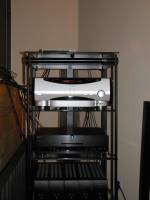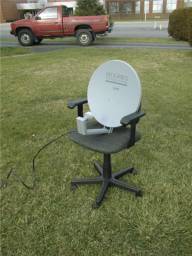|
|

|
Details(Updated October 27, 2001)
Projector
The biggest factor in my decision to choose this projector was the previously referenced review at projectorcentral.com. I also read reviews and discussion at AVS forum, which reinforced this review. I had been considering the Sony VPL-VW10HT, but the review at projectorcentral put me off. Also, this has an LCD panel with a 16:9 ratio, which is good for widescreen DVDs but since I will be watching a mixture of widescreen and 4:3 ratio material, I decided it would be simpler to have a 4:3 ratio screen. I was also considering some of the new DLP projectors such as the Seleco HT250. These were relatively expensive as they're not available for sale on the web yet, just via local dealers. Also there were some comments at AVS forum about problems with the early models. I ended up buying the projector from Projector People - didn't use mysimon.com as I did for the receiver and DVD player, as it doesn't seem to know about many of the specialist projector sites. They were offering it at a bit over 40% off the list price. Screen
Both the screen and the projector lift will be remote controlled. I haven't worked out the exact details yet, but am hoping to use X-10 automation for this and other remote operations. Receiver
I decided to buy a Kenwood VR4900, which is the top receiver in the Kenwood range. This is the silver box on the top shelf in the picture. It got consistently good reviews on all the web sites I found, including The Big Picture and Audio Review. While it has a lot of excellent features, the single biggest selling point for me was that it can convert all video output up to a component video signal. To digress slightly, there are three main types of video connection that can be used between a video source and a projector. In order of increasing quality, these are composite, S-video and component video connections. Normally only high quality DVD players would provide a component video output - my satellite receiver will output S-video, and my VCR will only output composite video. This means that with many setups you need to run all three types of connection to the projector. Since my projector will be mounted on the ceiling and will be a long way from the receiver (I will need roughly a 50 foot cable), it would be a pain to have to run three cables to it. With the Kenwood, the different types of video signal all go into the receiver and it outputs a single component video signal to the projector, so I just need to run one (albeit expensive!) component video cable between the receiver and projector. Having said that, I will also be running a second RGB cable between my PC and the projector (more below). One thing that was something of a pain was that the Kenwood receiver is about an inch wider than all my other components, and it wouldn't fit on my existing equipment stand, which was 18 inches wide. This forced me to buy an expensive new designer equipment stand made by Bell'O, which you can see in the picture above. DVD PlayerI also bought a new DVD player, the Sony 9000ES, which is Sony's high end player. This can generate a progressive scan output (in the 480p format, which is an HDTV format), which gives a higher picture quality. This refreshes all 600 lines on the screen in every frame, whereas a traditional (interlaced) image just refreshes every other line on the screen each frame. I had several DVDs that wouldn't play on my old system, but I haven't had a problem with any of them with the new system. The picture it produces is really outstanding. In addition to playing DVDs, it will play various other formats including CD, Video CD (VCD), and Super Audio CD (SACD), which is a new high quality audio format being pushed by Sony. It's hard to get these at the moment - I ordered a couple from Amazon (which has less than 100 titles), and so far have Verdi's Requiem and Meatloaf's Bat out of Hell (for contrast!). They both sound very good, but need to do more side by side listening to compare them with regular CDs (I have a very nice Bang and Olufsen CD player, which sounds great). As for less technical things, the player looks and feels really solid and high quality, AND it has a really cool blue light on the front :) !! (Even the real hard core audio- and video-philes at AVS Forum talked about the cool blue light!!). Phillips TiVo Personal Video RecorderMy TV viewing has significantly changed since I got a TiVo a couple of years ago. It's essentially a souped up VCR which uses a hard disk instead of tape to record shows. It's actually running the Linux operating system, for the techie geeks out there - though you never see this. It has a very intuitive user interface, and downloads program information every night, which makes it very easy to select what you want to record and enables the system to provide a lot of nice features. You can select a program and say that you want to record every episode. You can also watch something while it's still being recorded, and a nice function which takes advantage of this is that you can pause live TV (it just starts recording when you hit pause, and you can hit play again whenever you like). This is also useful for skipping the ads, as you can start watching a program 15 minutes late and just fast forward over any of the ads. TiVo just brought out version 2 of their software, which has a lot of nice enhancements that fix the biggest issues I had with the previous version. The major ehnancement for me is probably that if you ask for a "season pass" to record all episodes of a show, you can specify a priority for which show gets recorded if there is a clash. Previously it just wouldn't let you get a season pass if any episode overlapped with another season pass, which was very annoying. The latest version also gives you a lot more flexibility in searching for programs and specifying what should be recorded - you can search for everything including a certain actor or set of keywords for example, whereas before you could just search on the title. Hughes DSS satellite receiver
Bang and Olufsen CD playerPlugged into the home theater system I have a Bang and Olufsen BeoSound 9000 CD player which is very cool. It hangs on the wall and plays (and displays) 6 CDs. It's almost a piece of art as much as a CD player (that's a justification for its extortionate price, anyway!). You can see it on the wall in the background in this picture. PCI also have my PC connected into the projector, which can display XGA resolution (1024x768 pixels), as mentioned above. It's a Dell machine with a 1GHz Pentium III processor, 256MB of RAM, a high end NVidia GeForce2 Ultra graphics card with 64MB of video RAM, and 80GB of disk space. I have a cordless keyboard and mouse from Logitech, which work within a range of 20-30 feet or so from the PC, so I can use them from my normal viewing area. I have almost my entire CD collection stored on the PC in MP3 format, and the audio output is connected to the main amps and speakers via the Kenwood receiver, so I get a pretty good sound. I also just got a broadband internet connection (640Kbps DSL), which is fast enough to get pretty good streaming video which I can play on the big screen. Downstairs TVI have a second TV in the bedroom downstairs, which is an older 36" Sony Trinitron. While the Kenwood has multi-room capability, this is hooked up to display the same signal as the projector upstairs. I didn't really need the ability to watch two separate programs as I will just be watching in one place or the other, and this makes the control interface simpler. Remote controlOne of the challenges for the system is getting a good integrated remote control system. There are a large number of components in various different locations, using both Infrared (IR) and Radio Frequency (RF) remote control signals. In addition, I want to include control of lighting and the screen and projector lift. It's important to include macros to make everything simple to use. My plan is to develop a custom remote control system which uses a PC server with a web-based (HTML) user interface. |
| © 2000-2008 Peter Batty |
|
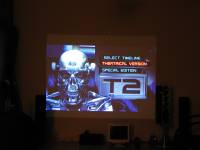
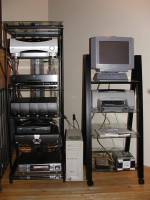
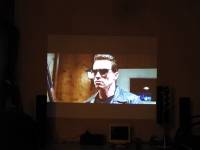

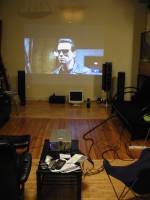
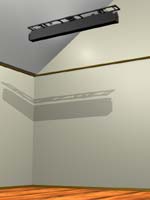
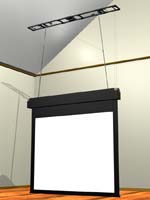 I
have a Stewart Grayhawk screen. Most home theater screens
have a gain greater than 1.0, which makes the image appear brighter.
However, with very bright projectors like the Sanyo, a light gray screen which
has a gain of less than 1.0 actually improves the picture quality by making
blacks appear darker.
I
have a Stewart Grayhawk screen. Most home theater screens
have a gain greater than 1.0, which makes the image appear brighter.
However, with very bright projectors like the Sanyo, a light gray screen which
has a gain of less than 1.0 actually improves the picture quality by making
blacks appear darker.
 A
challenge in the loft is the location of the screen. In my old place, I
had an electric drop down screen that retracted into a horizontal cylinder
mounted on the wall. I have a nice sculpture on the wall where I want the
image to be projected, and the ceiling is pretty high (see the picture on the
right). I don't really want a cylinder containing the screen mounted two
thirds of the way up the wall. I had been thinking that the ideal
solution would be if I could somehow drop a cylinder down from the ceiling, and
then I stumbled on the "cable climber" at the Stewart web site, which
is pictured on the left. When stored, the cylinder containing the screen
is all the way up to the ceiling. When it drops down, the cables lower the
cylinder to the correct position, and then the screen drops down from there.
However, I finally got a price quote for this which even I decided was
outrageous, and I have now decided to go for plan B, a screen that has extra
masking material at the top and will wind all the way up into a fixed cylinder
on the ceiling. I'm still going for the Stewart Grayhawk.
A
challenge in the loft is the location of the screen. In my old place, I
had an electric drop down screen that retracted into a horizontal cylinder
mounted on the wall. I have a nice sculpture on the wall where I want the
image to be projected, and the ceiling is pretty high (see the picture on the
right). I don't really want a cylinder containing the screen mounted two
thirds of the way up the wall. I had been thinking that the ideal
solution would be if I could somehow drop a cylinder down from the ceiling, and
then I stumbled on the "cable climber" at the Stewart web site, which
is pictured on the left. When stored, the cylinder containing the screen
is all the way up to the ceiling. When it drops down, the cables lower the
cylinder to the correct position, and then the screen drops down from there.
However, I finally got a price quote for this which even I decided was
outrageous, and I have now decided to go for plan B, a screen that has extra
masking material at the top and will wind all the way up into a fixed cylinder
on the ceiling. I'm still going for the Stewart Grayhawk. 